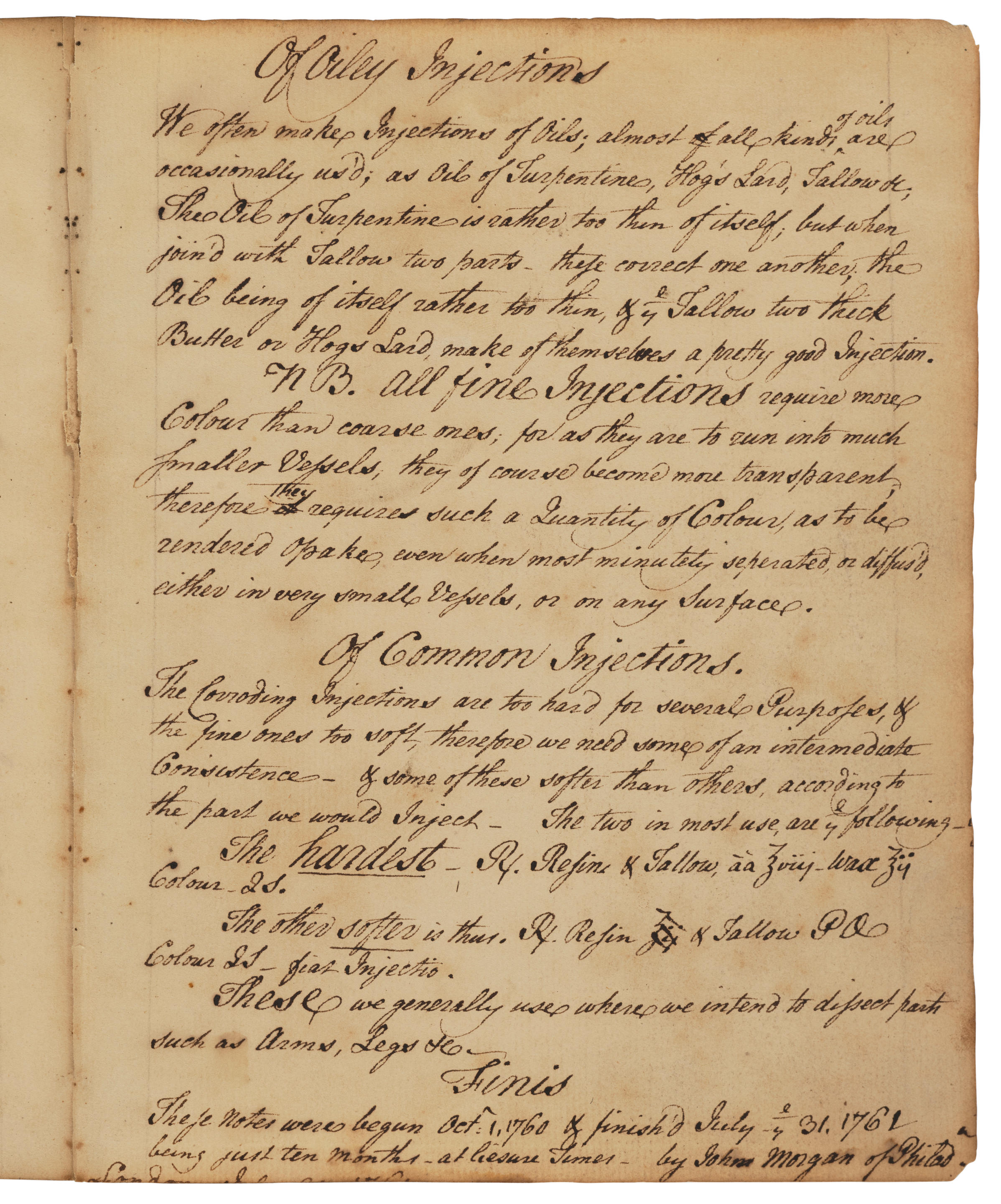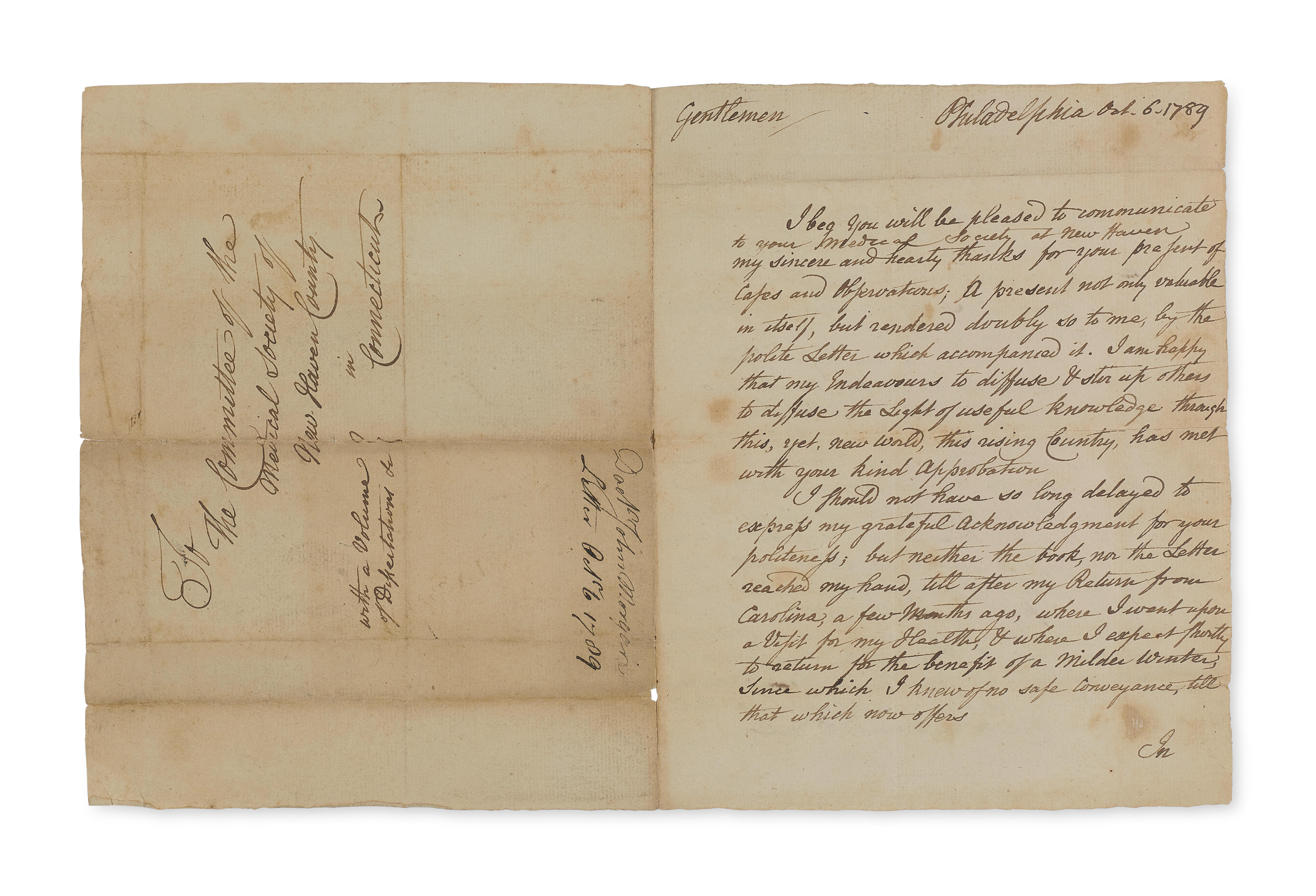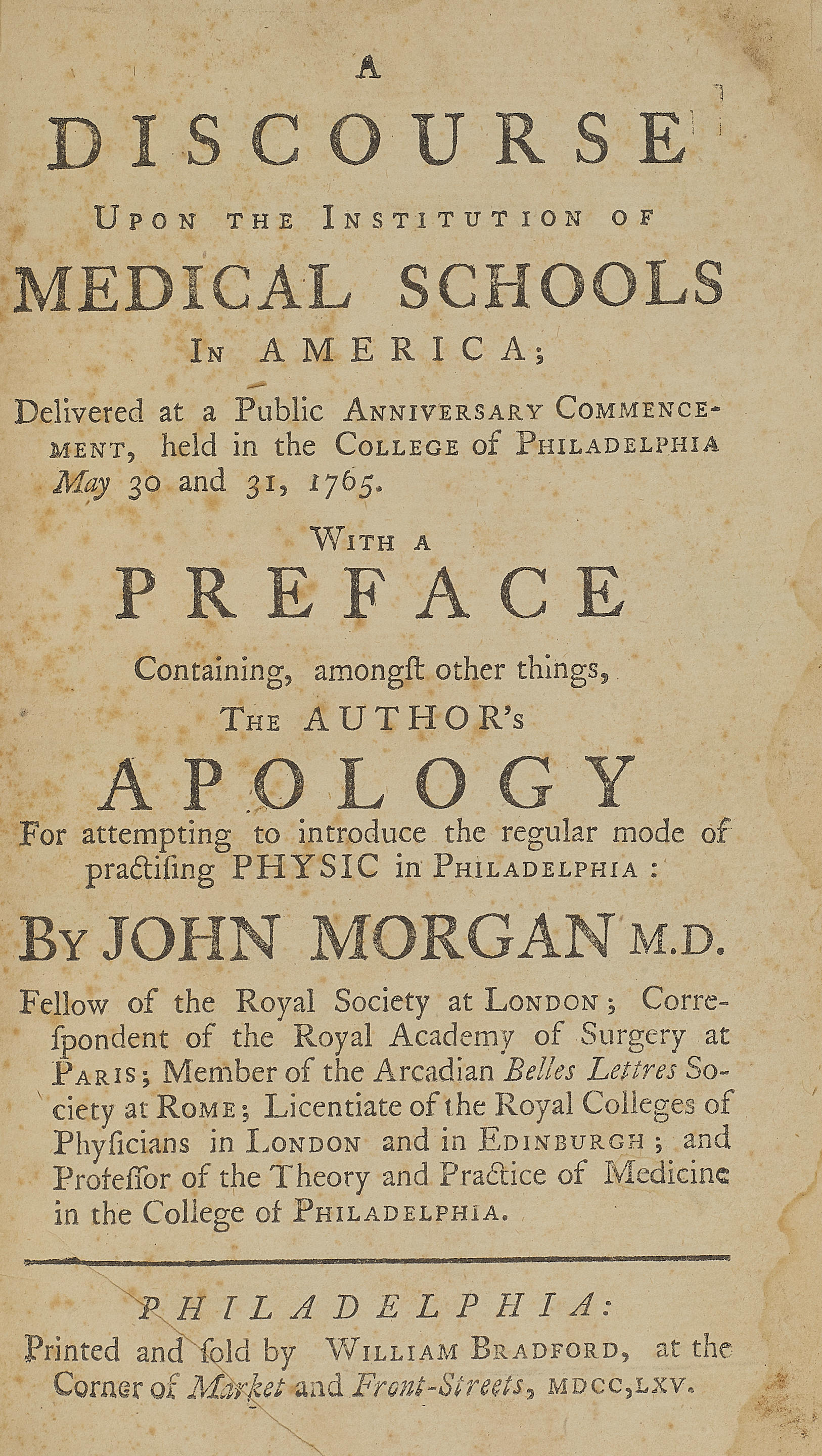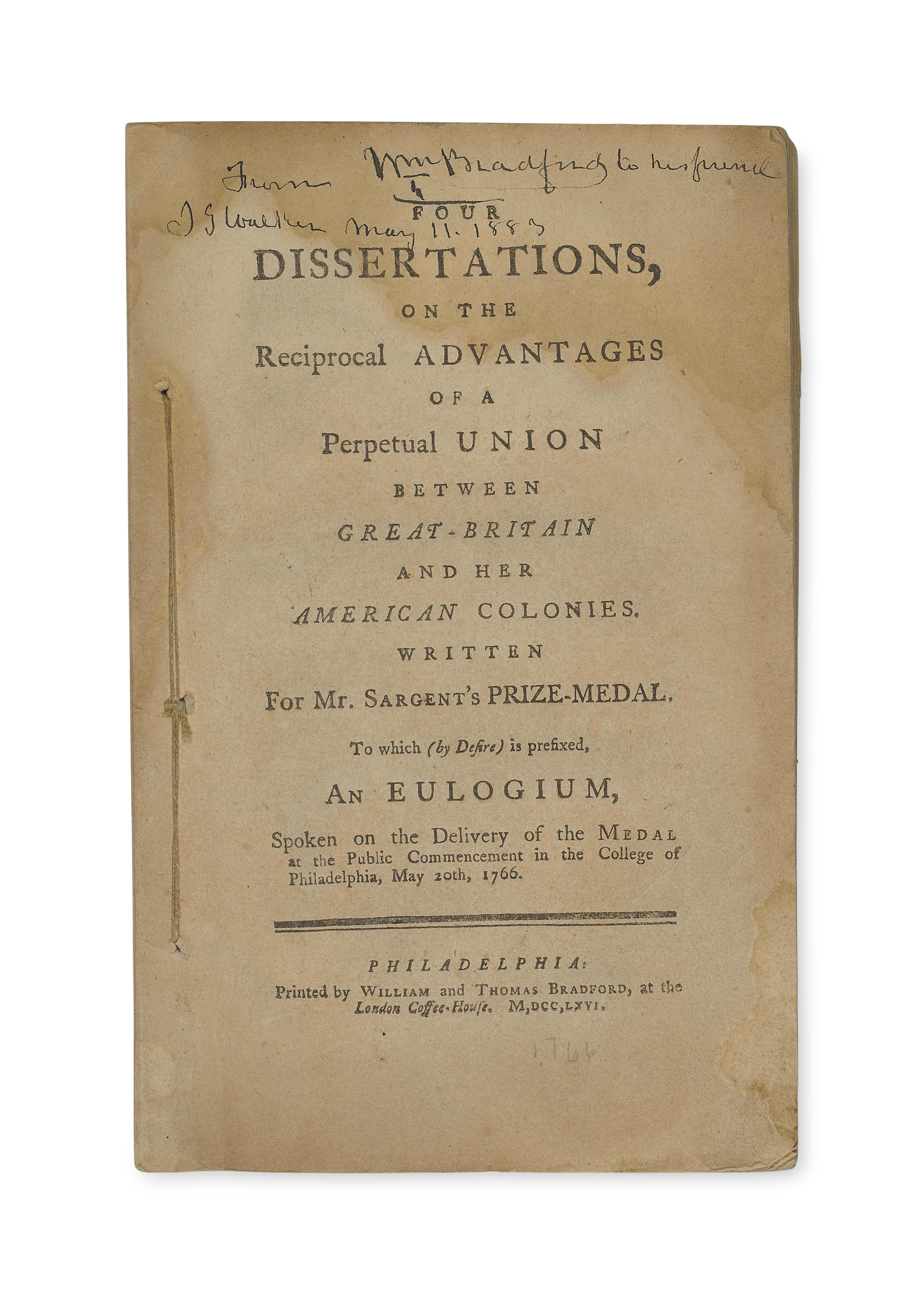MORGAN, JOHN. 1735-1789. Autograph Medical Manuscript Signed ("John Morgan") being more than 50 lectures on the practice of medicine, including anatomy, physiology, pathology, and surgery, with references to primary authorities both modern and ancient, citing first hand primary case history from the most renowned doctors of the time, approximately 272 pages, ink on laid paper, watermarked "LV Gerrevink/W" written primarily recto only, catchwords, 255 leaves complete, signed in 8s A-Z, A-H, with Z1 removed leaving a partial stub written on verso, catchword from X8 matching Z2, initial signature leaves for each gathering numbered at upper corner, [no 34] – 65, autograph note to verso of H8v: "These notes were begun Oct 1 1760 & finish'd July ye 31, 1761 being just ten months — at leisure times — by John Morgan of Philada," and beneath (shaved) "[London, July (illegible), 1761," some page edges shaved with loss to signature marks, marginal notes, or headers, but no text loss, disbound, with spine split in places, some moisture damage, some chipping to leaves at corners.
Provenance: "Cumberland College Library" (19th-century manuscript note in ink to verso of C7v); from a private American medical collection.
"So great was his diligence and humanity in attending the sick and wounded who were the subjects of his care, that I well remember to have heard it said that if it were possible for any man to merit Heaven by his good works. Dr. Morgan would deserve it for his."
— Benjamin Rush
AN INCREDIBLE DISCOVERY OF AMERICAN MEDICAL HISTORY — A PREVIOUSLY UNKNOWN EXTENSIVE AUTOGRAPH MEDICAL MANUSCRIPT OF JOHN MORGAN THE "FATHER OF AMERICAN MEDICINE."
The eldest son of a prominent Philadelphia family and neighbor of Benjamin Franklin Dr. John Morgan founded the first medical college in America in 1765. He had spent 15 years previous pursuing knowledge in medicine: first as a student in Philadelphia; then as a doctor in the Army during the French and Indian War, including as a surgeon on Forbes's expedition and the capture of Fort Duquesne (Pittsburgh); then in London where, with the valued assistance of Benjamin Franklin he met and trained with the most important medical doctors of the period; then two years at Edinburgh for his advanced medical degree there, again training under the most knowledgeable doctors of his time; and finally, again with the guidance of Franklin, on a grand tour of the Europe where he again met with the most important men of medicine in Europe. Upon completion of his tour, he returned to America, and on May 30, 1765, delivered his inaugural address at the College of Pennsylvania announcing the creation of the first medical college in the colonies. In 1775, he was appointed by George Washington as the head medical doctor of the Continental Army, essentially America's first Surgeon General. Medical historian Ira Rutkow notes Morgan had been "'deservedly styled the founder of American medicine,' but he was more than that: Morgan was medicine's main attraction" (Seeking the Cure: A History of American Medicine, p 20).
The discovery of this previously unknown medical manuscript is of utmost importance to the history of medicine, written throughout his stay in London, 1760-1761, where he practiced with and trained under John Hunter and John Fothergill These early writings, likely drawn from a variety of sources, comprise a series of lectures that represent not only the most up-to-date and primary applications of medicine during the period from the masters of the craft, but also the inkling of a course of study that would become five years later the first medical college in America.
Morgan's writings represent primary, first-hand knowledge from the greatest doctors of the time, including previously unpublished case studies and observations. He draws from both the ancients, referencing Celsus and Sesalpinus, through "ye immortal Harvey" and Boerhaave, but also most interestingly, he provides personal first-hand knowledge from and references to a variety of contemporary sources such as John Hunter Cheselden, Von Haller, Malpighi, Cowper, and the anatomical works of Gautier. For the lectures on Optics and the eye, his sources include Sir Isaac Newton as well as Cheyne and Gravesande.
The story is told of Morgan's mentor John Hunter that when he was asked by a student's (William Physick, father of American surgery) father for a list of books that his son would study, Hunter went to the dissecting room where the cadavers lay, saying, "These are the books your son will learn under my direction ... The others are fit for very little." The lectures contained in Morgan's manuscript reflect Hunter's hands-on philosophy, but are balanced with the historical perspective of Morgan's own education and learning.
Morgan's numbering of the manuscript, beginning with an inferred (but shaved) "No 34" on the first gathering signed "A" and continuing with the holograph and present "No. 35" at signature "B" through holograph "No 65" at final signature H (shaved), indicates the likely one-time presence of a first volume.
The dating of the manuscript "begun Oct 1 1760 & finish'd July ye 31, 1761" suggests that Morgan had possibly begun considering the creation of a course for medical education before his arrival in Edinburgh in 1761. He was encouraged in the pursuit at Edinburgh through conversations with his then friend William Shippen, as well as by Hunter, Fothergill, and William Watson
Morgan's primary biographer Whitfield Bell ascribes the lack of scholarship on Morgan as owing in part to a lack of primary material. The Morgan family donated a holograph journal to the University of Pennsylvania which covers his travels from Rome to London in 1764, and a small portion of a journal written in Rome during the same period. There are also scattered institutional holdings of letters, prominently at the American Philosophical Society. But, as Bell put the matter, "In any case, relatively few Morgan papers have survived." According to Julia Morgan Harding in her sketch of Morgan for the publication of his Journal, the papers and books collected by Morgan before the Revolution were all destroyed when the British burned his house at Bordentown where he had moved them when Philadelphia had become too dangerous. The survival of the present manuscript provides major primary source material for Morgan, and more importantly for the inception of medicine in America, and the history of medicine more broadly. The discovery of this previously unknown manuscript represents a major opportunity for scholarship in the history of medicine.
REFERENCES:
Bell, Whitfield J., Jr. "John Morgan." Bulletin of the History of Medicine, Vol 22, No. 5 (1948), pp 543-561.
Harding, Julia Morgan "Biographical Sketch" in The Journal of Dr. John Morgan of Philadelphia: From the City of Rome to the City of London, 1764. (Philadelphia: Privately printed, 1907).
Rogers, Fred B. "John Morgan's Outlines of a General History of Physic (1765): Medical History in 18th-Century Academic Medical Teaching." Journal of the History of Medicine and Allied Sciences, Vol 14, Number 4 (1959), pp 440-445.
Rutkow, Ira. Seeking the Cure: A History of Medicine in America. New York: Scribner, 2010.
For a complete list of contents and references/case studies, please contact the department.
MORGAN, JOHN. 1735-1789. Autograph Medical Manuscript Signed ("John Morgan") being more than 50 lectures on the practice of medicine, including anatomy, physiology, pathology, and surgery, with references to primary authorities both modern and ancient, citing first hand primary case history from the most renowned doctors of the time, approximately 272 pages, ink on laid paper, watermarked "LV Gerrevink/W" written primarily recto only, catchwords, 255 leaves complete, signed in 8s A-Z, A-H, with Z1 removed leaving a partial stub written on verso, catchword from X8 matching Z2, initial signature leaves for each gathering numbered at upper corner, [no 34] – 65, autograph note to verso of H8v: "These notes were begun Oct 1 1760 & finish'd July ye 31, 1761 being just ten months — at leisure times — by John Morgan of Philada," and beneath (shaved) "[London, July (illegible), 1761," some page edges shaved with loss to signature marks, marginal notes, or headers, but no text loss, disbound, with spine split in places, some moisture damage, some chipping to leaves at corners.
Provenance: "Cumberland College Library" (19th-century manuscript note in ink to verso of C7v); from a private American medical collection.
"So great was his diligence and humanity in attending the sick and wounded who were the subjects of his care, that I well remember to have heard it said that if it were possible for any man to merit Heaven by his good works. Dr. Morgan would deserve it for his."
— Benjamin Rush
AN INCREDIBLE DISCOVERY OF AMERICAN MEDICAL HISTORY — A PREVIOUSLY UNKNOWN EXTENSIVE AUTOGRAPH MEDICAL MANUSCRIPT OF JOHN MORGAN THE "FATHER OF AMERICAN MEDICINE."
The eldest son of a prominent Philadelphia family and neighbor of Benjamin Franklin Dr. John Morgan founded the first medical college in America in 1765. He had spent 15 years previous pursuing knowledge in medicine: first as a student in Philadelphia; then as a doctor in the Army during the French and Indian War, including as a surgeon on Forbes's expedition and the capture of Fort Duquesne (Pittsburgh); then in London where, with the valued assistance of Benjamin Franklin he met and trained with the most important medical doctors of the period; then two years at Edinburgh for his advanced medical degree there, again training under the most knowledgeable doctors of his time; and finally, again with the guidance of Franklin, on a grand tour of the Europe where he again met with the most important men of medicine in Europe. Upon completion of his tour, he returned to America, and on May 30, 1765, delivered his inaugural address at the College of Pennsylvania announcing the creation of the first medical college in the colonies. In 1775, he was appointed by George Washington as the head medical doctor of the Continental Army, essentially America's first Surgeon General. Medical historian Ira Rutkow notes Morgan had been "'deservedly styled the founder of American medicine,' but he was more than that: Morgan was medicine's main attraction" (Seeking the Cure: A History of American Medicine, p 20).
The discovery of this previously unknown medical manuscript is of utmost importance to the history of medicine, written throughout his stay in London, 1760-1761, where he practiced with and trained under John Hunter and John Fothergill These early writings, likely drawn from a variety of sources, comprise a series of lectures that represent not only the most up-to-date and primary applications of medicine during the period from the masters of the craft, but also the inkling of a course of study that would become five years later the first medical college in America.
Morgan's writings represent primary, first-hand knowledge from the greatest doctors of the time, including previously unpublished case studies and observations. He draws from both the ancients, referencing Celsus and Sesalpinus, through "ye immortal Harvey" and Boerhaave, but also most interestingly, he provides personal first-hand knowledge from and references to a variety of contemporary sources such as John Hunter Cheselden, Von Haller, Malpighi, Cowper, and the anatomical works of Gautier. For the lectures on Optics and the eye, his sources include Sir Isaac Newton as well as Cheyne and Gravesande.
The story is told of Morgan's mentor John Hunter that when he was asked by a student's (William Physick, father of American surgery) father for a list of books that his son would study, Hunter went to the dissecting room where the cadavers lay, saying, "These are the books your son will learn under my direction ... The others are fit for very little." The lectures contained in Morgan's manuscript reflect Hunter's hands-on philosophy, but are balanced with the historical perspective of Morgan's own education and learning.
Morgan's numbering of the manuscript, beginning with an inferred (but shaved) "No 34" on the first gathering signed "A" and continuing with the holograph and present "No. 35" at signature "B" through holograph "No 65" at final signature H (shaved), indicates the likely one-time presence of a first volume.
The dating of the manuscript "begun Oct 1 1760 & finish'd July ye 31, 1761" suggests that Morgan had possibly begun considering the creation of a course for medical education before his arrival in Edinburgh in 1761. He was encouraged in the pursuit at Edinburgh through conversations with his then friend William Shippen, as well as by Hunter, Fothergill, and William Watson
Morgan's primary biographer Whitfield Bell ascribes the lack of scholarship on Morgan as owing in part to a lack of primary material. The Morgan family donated a holograph journal to the University of Pennsylvania which covers his travels from Rome to London in 1764, and a small portion of a journal written in Rome during the same period. There are also scattered institutional holdings of letters, prominently at the American Philosophical Society. But, as Bell put the matter, "In any case, relatively few Morgan papers have survived." According to Julia Morgan Harding in her sketch of Morgan for the publication of his Journal, the papers and books collected by Morgan before the Revolution were all destroyed when the British burned his house at Bordentown where he had moved them when Philadelphia had become too dangerous. The survival of the present manuscript provides major primary source material for Morgan, and more importantly for the inception of medicine in America, and the history of medicine more broadly. The discovery of this previously unknown manuscript represents a major opportunity for scholarship in the history of medicine.
REFERENCES:
Bell, Whitfield J., Jr. "John Morgan." Bulletin of the History of Medicine, Vol 22, No. 5 (1948), pp 543-561.
Harding, Julia Morgan "Biographical Sketch" in The Journal of Dr. John Morgan of Philadelphia: From the City of Rome to the City of London, 1764. (Philadelphia: Privately printed, 1907).
Rogers, Fred B. "John Morgan's Outlines of a General History of Physic (1765): Medical History in 18th-Century Academic Medical Teaching." Journal of the History of Medicine and Allied Sciences, Vol 14, Number 4 (1959), pp 440-445.
Rutkow, Ira. Seeking the Cure: A History of Medicine in America. New York: Scribner, 2010.
For a complete list of contents and references/case studies, please contact the department.









.jpg)
Testen Sie LotSearch und seine Premium-Features 7 Tage - ohne Kosten!
Lassen Sie sich automatisch über neue Objekte in kommenden Auktionen benachrichtigen.
Suchauftrag anlegen